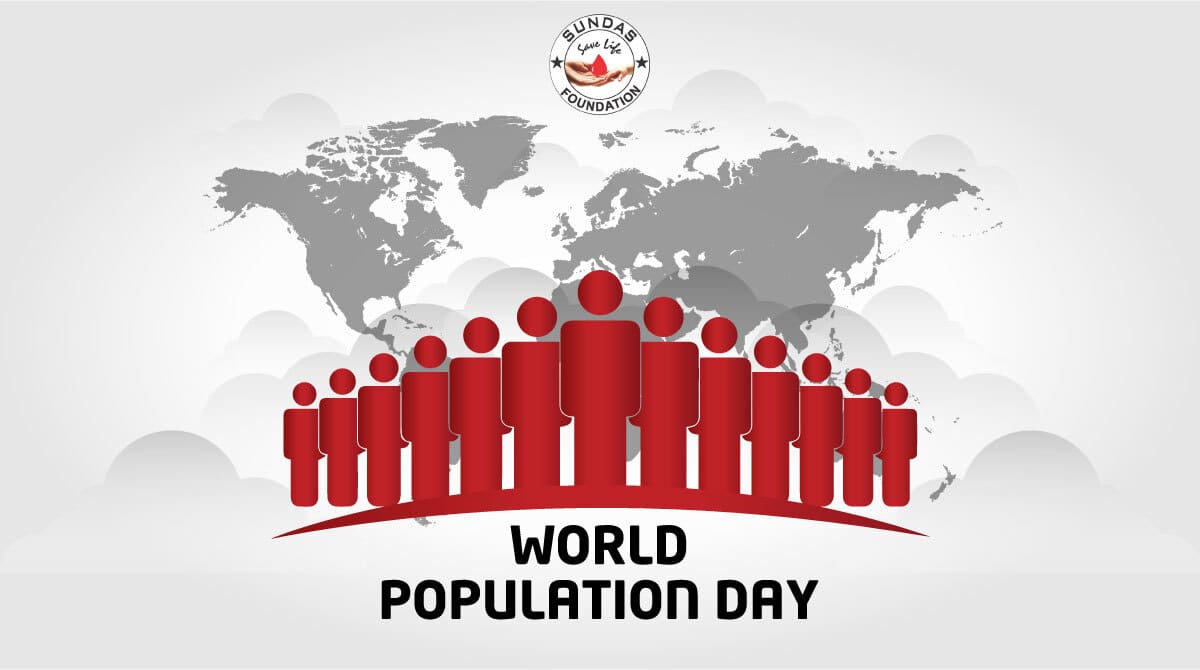
World Population Day
Every year on July 11, the world comes together to observe World Population Day, which encourages reflection on the challenges and opportunities of population growth. From questions like "how many people live on Earth?" to issues like health equity and disease prevention, this day brings critical topics to the forefront of public attention.
In a world where over 8 billion people coexist, there are countless stories of survival, struggle, and hope, especially among those facing genetic disorders like thalassemia. In this article, we'll explore the significance of World Population Day, its history, global trends, and the vital role of health-focused institutions like Sundas Foundation, which provides free treatment to poor thalassemia patients in Pakistan.
What is World Population Day?
World Population Day, initiated by the United Nations Development Program (UNDP), occurs annually on July 11. It's not just an awareness day, but it also provides an opportunity to discuss urgent population growth-related concerns, including healthcare access and affordability, city as well as sustainable development efforts. Across countries, including Pakistan and many European nations, this day is observed through seminars, awareness campaigns, and discussions led by government departments, NGOs, and civil society organizations. Organizations such as the United Nations Population Fund (UNFPA), WHO, and national departments, including the Population Welfare Department in Pakistan, actively participate in campaigns to educate people about the importance of balancing population growth with available resources.
World Population Trends
Population growth continues to vary across the globe. As of 2025, the estimated global population is approximately 8.1 billion people, with projections suggesting it could reach 9.7 billion by 2050 if current trends continue. Asia is home to nearly 60% of the world’s population, followed by Africa, Europe, and the America. With over 240 million people, Pakistan ranks as the fifth most populous country. This rapid population growth presents significant challenges, particularly in low and middle-income countries, which put added pressure on healthcare, education, and food systems. Addressing these issues will require careful planning and investment to ensure sustainable development in the face of increasing demands.
History of World Population Day
The first official World Population Day was observed in 1990, following a recommendation by the UNDP Governing Council. It was created to shift public attention toward critical population issues, such as family planning, maternal health, gender equality, and access to basic healthcare.
Since its inception, World Population Day has been celebrated globally, with each year's theme focusing on a specific area. In past years, topics have ranged from "Rights and Choices are the Answer" to "Investing in Teenage Girls."
In Pakistan, initiatives led by the Population Welfare Department in collaboration with non-governmental partners have helped raise awareness of reproductive rights and preventive healthcare.
How Many People Are in the World – Facts and Insights
As of mid-2025, the global population has reached approximately 8.1 billion people. Around 385,000 babies are born daily, while roughly 150,000 people pass away. This results in a net population growth of about 235,000 people daily. Interestingly, over 40% of the global population is under 25. Despite significant technological and medical advancements, many individuals—particularly in South Asia and parts of Africa—still lack access to essential services, including healthcare and proper nutrition. These figures highlight the urgent need for sustainable planning and health awareness campaigns, especially in light of World Population Day, to address the challenges and ensure a healthier future for all.
Global Health and Population
With such a large population, maintaining public health becomes increasingly complex. From dealing with pandemics to managing genetic disorders, health systems are under constant pressure.
Average Health Statistics in 2025:
- Average life expectancy: 73.2 years
- Infant mortality rate: 27 per 1,000 live births globally
- Access to healthcare: Over 2 billion people still lack basic healthcare services
- Chronic diseases: Rise in lifestyle-related diseases due to urbanization
Overcrowding in urban centers, poor sanitation, malnutrition, and inadequate maternal health services are among the global health sector's challenges, particularly in densely populated countries like Pakistan.
One of the most pressing health challenges in countries with high populations is genetic disorders, such as thalassemia.
Thalassemia – A Growing Concern in a Crowded World
Thalassemia is an inherited blood disorder that causes the body to produce less hemoglobin than normal, leading to severe anemia. With population growth and a lack of awareness, especially in countries where cousin marriages are culturally common, thalassemia is becoming more prevalent.
How many thalassemia patients are there in the world?
An estimated 300,000 babies are born with thalassemia major each year. Over 7% of the global population is carriers of the thalassemia gene. Pakistan alone has over 100,000 registered thalassemia patients, and thousands more remain undiagnosed.
How to Stay Safe from Thalassemia
Unlike many other diseases, thalassemia can be prevented. Prevention requires awareness, responsibility, and medical Support.
Preventive Measures:
- Pre-marital Screening: A simple blood test to detect carrier status.
- Genetic Counseling: Helps couples understand the risks of passing on the disorder.
- Public Education: Communities must be informed about the consequences of genetic diseases.
- Discouraging Consanguineous Marriages: Raising awareness about the risks of cousin marriages in rural and urban settings.
Educational campaigns led by health organizations and government bodies, such as the Population Welfare Department in Pakistan, are essential in promoting genetic testing and counseling.
Thalassemia Treatment – A Lifelong Journey
Thalassemia patients require regular blood transfusions, typically every 2 to 3 weeks, in conjunction with iron chelation therapy to manage iron overload. Treatment costs are high and ongoing, making it unaffordable for many underprivileged families.
Treatment Options:
- Blood Transfusions (Monthly)
- Chelation Therapy
- Bone Marrow Transplant (only available in rare cases and at high cost)
- Psychosocial Support for children and families
Unfortunately, the high cost of treatment means that many thalassemia patients go without proper care unless helped by charitable organizations.
Sundas Foundation – Offering Free Treatment and Hope
Despite all these challenges, the Sundas Foundation has emerged as a beacon of hope. Established to support children suffering from blood disorders such as thalassemia, hemophilia, and blood cancer, the foundation operates on a mission of compassion and community support.
Services Offered by Sundas Foundation:
- Free blood transfusions to registered thalassemia patients
- Safe and screened blood supply through volunteer donor networks
- Medical and psychological counseling
- Public awareness campaigns in collaboration with government bodies and schools
- Partnerships with the Population Welfare Department in Pakistan
Operating across various cities in Pakistan, including Lahore, Faisalabad, and Gujranwala, Sundas Foundation helps hundreds of children live better lives with dignity and access essential medical Support every month.
Why Donate to Sundas Foundation?
Your Zakat and donations provide direct Support for treatment and care, funding lifesaving transfusions and medication. These contributions offer underprivileged families the hope and health they need to survive. Whether in Pakistan or Europe, your donation can save lives and bring smiles to children who depend on monthly Support for survival. You can also make a difference by becoming a blood donor and giving the gift of life.
World Population Day serves as a reminder that behind every statistic is a life—whether it's a child, a family, or a community. As the global population grows, we must increase our collective efforts to ensure that healthcare, awareness, and Support are accessible to all. Early prevention, proper treatment, and organizations like the Sundas Foundation are vital lifelines for diseases like thalassemia. This July 11, as we reflect on the state of the world’s population, let's also take action by donating, educating, and advocating for the most vulnerable among us.

